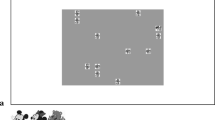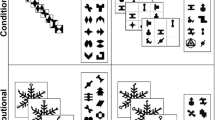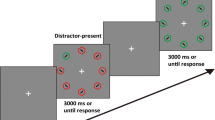Abstract
In visual statistical learning (VSL), one can extract and exhibit memory for the statistical regularities of target locations in an incidental manner. The current study examined the development of VSL using the probability cueing paradigm with salient perceptual cues. We also investigated the elicited attention gradient phenomenon in VSL. In a visual search task, the target first appeared more often in one quadrant (i.e., rich) than the other quadrants (i.e., sparse). Then, the participants rotated the screen by 90° and the targets appeared in the four quadrants with equal probabilities. Each quadrant had a unique background color and was, hence, associated with salient perceptual cues. 1st–4th graders and adults participated. All participants showed probability cueing effects to a similar extent. We observed an attention gradient phenomenon, as all participants responded slower to the sparse quadrant that was distant from, rather than the ones that were adjacent to the rich quadrant. In the testing phase, all age groups showed persistent attentional biases based on both egocentric and allocentric perspectives. These findings showed that probability cueing effects may develop early, that perceptual cues can bias attention guidance during VSL for both children and adults, and that VSL can elicit a spaced-based attention gradient phenomenon for children and adults.






Similar content being viewed by others
Notes
If we use the critical t value of 3.182 (df = 3, since there are 4 epochs), only 7 subjects’ results were significant.
References
Allenmark, F., Zhang, B., Liesefeld, H. R., Shi, Z., Müller, H. J., Allenmark, F., & Müller, H. J. (2019). Probability Cueing of Singleton-Distractor Locations in Visual Search: Priority-Map- Versus Dimension-Based Inhibition? Journal of Experimental Psychology: Human Perception and Performance, 45(9), 1146–1163. https://doi.org/10.1037/xhp0000652
Brockmole, J. R., & Henderson, J. M. (2006a). Using real-world scenes as contextual cues for search. Visual Cognition, 13(1), 99–108.
Brockmole, J. R., & Henderson, J. M. (2006b). Short article: Recognition and attention guidance during contextual cueing in real-world scenes: Evidencefrom eye movements. Quarterly journal of experimental psychology, 59(7), 1177–1187.
Cavallina, C., Puccio, G., Capurso, M., Bremner, A. J., & Santangelo, V. (2018). Cognitive development attenuates audiovisual distraction and promotes the selection of task-relevant perceptual saliency during visual search on complex scenes. Cognition, 180(June), 91–98. https://doi.org/10.1016/j.cognition.2018.07.003
Chun, M. M., & Jiang, Y. (1998). Contextual cueing: Implicit learning and memory of visual context guides spatial attention. Cognitive Psychology, 36(1), 28–71.
Chun, M. M., & Jiang, Y. (2003). Implicit, long-term spatial contextual memory. Journal of Experimental Psychology: Learning, Memory, and Cognition, 29(2), 224.
Fiser, J., & Aslin, R. N. (2002). Statistical learning of higher-order temporal structure from visual shape sequences. Journal of Experimental Psychology: Learning, Memory, and Cognition, 28(3), 458–467. https://doi.org/10.1037/0278-7393.28.3.458
Gaspelin, N., Margett-Jordan, T., & Ruthruff, E. (2015). Susceptible to distraction: Children lack top-down control over spatial attention capture. Psychonomic Bulletin and Review, 22(2), 461–468. https://doi.org/10.3758/s13423-014-0708-0
Goschy, H., Bakos, S., Müller, H. J., & Zehetleitner, M. (2014). Probability cueing of distractor locations: both intertrial facilitation and statistical learning mediate interference reduction. Frontiers in psychology, 5, 1195.
Goujon, A., Didierjean, A., & Thorpe, S. (2015). Investigating implicit statistical learning mechanisms through contextual cueing. Trends in Cognitive Sciences, 19(9), 524–533.
Hommel, B., Li, K. Z. H., & Li, S.-C. (2004). Visual Search Across the Life Span. https://doi.org/10.1037/0012-1649.40.4.545
Jiang, Y. V., Capistrano, C. G., Esler, A. N., & Swallow, K. M. (2013a). Directing attention based on incidental learning in children with autism spectrum disorder. Neuropsychology, 27(2), 161–169. https://doi.org/10.1037/a0031648
Jiang, Y. V., Swallow, K. M., & Capistrano, C. G. (2013b). Visual search and location probability learning from variable perspectives. Journal of Vision, 13(6), 13–13. https://doi.org/10.1167/13.6.13
Jiang, Y. V., Swallow, K. M., & Rosenbaum, G. M. (2013c). Guidance of spatial attention by incidental learning and endogenous cuing. Journal of Experimental Psychology: Human Perception and Performance, 39(1), 285–297. https://doi.org/10.1037/a0028022
Jiang, Y. V., Swallow, K. M., Rosenbaum, G. M., & Herzig, C. (2013d). Rapid acquisition but slow extinction of an attentional bias in space. Journal of Experimental Psychology: Human Perception and Performance, 39(1), 87–99. https://doi.org/10.1037/a0027611
Jiang, Y. V., & Swallow, K. M. (2013). Spatial reference frame of incidentally learned attention. Cognition, 126(3), 378–390. https://doi.org/10.1016/j.cognition.2012.10.011
Jiang, Y. V., Won, B. Y., & Swallow, K. M. (2014a). First saccadic eye movement reveals persistent attentional guidance by implicit learning. Journal of Experimental Psychology: Human Perception and Performance, 40(3), 1161–1173. https://doi.org/10.1037/A0035961
Jiang, Y. V., Swallow, K. M., & Sun, L. (2014b). Egocentric coding of space for incidentally learned attention: Effects of scene context and task instructions. Journal of Experimental Psychology: Learning Memory and Cognition, 40(1), 233–250. https://doi.org/10.1037/a0033870
Jiang, Y. V., & Won, B. Y. (2015). Spatial scale, rather than nature of task or locomotion, modulates the spatial reference frame of attention. Journal of Experimental Psychology: Human Perception and Performance, 41(3), 866–878. https://doi.org/10.1037/xhp0000056
Kirkham, N. Z., Slemmer, J. A., & Johnson, S. P. (2002). Visual statistical learning in infancy: Evidence for a domain general learning mechanism. Cognition, 83(2), B35–B42. https://doi.org/10.1016/S0010-0277(02)00004-5
LaBerge, D., & Brown, V. (1989). Theory of Attentional Operations in Shape Identification. Psychological Review, 96(1), 101–124. https://doi.org/10.1037/0033-295X.96.1.101
Leber, A. B., Gwinn, R. E., Hong, Y., & O’Toole, R. J. (2016). Implicitly learned suppression of irrelevant spatial locations. Psychonomic Bulletin and Review, 23(6), 1873–1881. https://doi.org/10.3758/s13423-016-1065-y
Levine, L. E., & Munsch, J. (2010). Child development: An active learning approach: An active learning approach. Addison: Sage.
Liesefeld, H. R., & Müller, H. J. (2020). A theoretical attempt to revive the serial/parallel-search dichotomy. Attention, Perception, and Psychophysics, 82(1), 228–245. https://doi.org/10.3758/s13414-019-01819-z
Lookadoo, R., Yang, Y., & Merrill, E. C. (2017). Encouraging top-down attention in visual search: A developmental perspective. Attention, Perception, and Psychophysics,. https://doi.org/10.3758/s13414-017-1379-5
Merrill, E. C., Conners, F. A., Yang, Y., & Weathington, D. (2014). The acquisition of contextual cueing effects by persons with and without intellectual disability. Research in Developmental Disabilities. https://doi.org/10.1016/j.ridd.2014.05.026
Reber, A. S. (1989). Implicit learning and tacit knowledge. Journal of Experimental Psychology: General, 118(3), 219.
Saffran, J. R., Aslin, R. N., & Newport, E. L. (1996). Statistical learning by 8-month-old infants. Science, 274(5294), 1926–1928. https://doi.org/10.1126/science.274.5294.1926
Sauter, M., Liesefeld, H. R., Zehetleitner, M., & Müller, H. J. (2018). Region-based shielding of visual search from salient distractors: Target detection is impaired with same- but not different-dimension distractors. Attention, Perception, and Psychophysics, 80(3), 622–642. https://doi.org/10.3758/s13414-017-1477-4
Saffran, J. R., & Kirkham, N. Z. (2018). Infant statistical learning. Annual Review of Psychology, 69(1), 181–203. https://doi.org/10.1146/annurev-psych-122216-011805
Theeuwes, J. (2010). Top-down and bottom-up control of visual selection. Acta Psychologica, 135(2), 77–99. https://doi.org/10.1016/j.actpsy.2010.02.006
Vadillo, M. A., Linssen, D., Orgaz, C., Parsons, S., & Shanks, D. R. (2020). Unconscious or underpowered? Probabilistic cuing of visual attention. Journal of Experimental Psychology: General, 149(1), 160–181. https://doi.org/10.1037/xge0000632
Wang, B., & Theeuwes, J. (2018a). Statistical regularities modulate attentional capture. Journal of Experimental Psychology. Human Perception and Performance, 44(1), 13–17. https://doi.org/10.1037/xhp0000472
Wang, B., & Theeuwes, J. (2018b). Statistical regularities modulate attentional capture independent of search strategy. Attention, Perception, and Psychophysics, 80(7), 1763–1774. https://doi.org/10.3758/s13414-018-1562-3
Yang, Y., & Merrill, E. C. (2014). The impact of distracter-target similarity on contextual cueing effects of children and adults. Journal of Experimental Child Psychology. https://doi.org/10.1016/j.jecp.2013.10.009
Yang, Y., & Merrill, E. C. (2015a). Age-related similarities in contextual cueing in the presence of unpredictive distracters. Journal of Genetic Psychology. https://doi.org/10.1080/00221325.2014.995585
Yang, Y., & Merrill, E. C. (2015b). Response cost to repeated displays—When previous distractors become targets. Quarterly Journal of Experimental Psychology, 68(4), 625–634. https://doi.org/10.1080/17470218.2015.1007149
Yang, Y., & Merrill, E. C. (2015c). The impact of signal-to-noise ratio on contextual cueing in children and adults. Journal of Experimental Child Psychology. https://doi.org/10.1016/j.jecp.2014.12.005
Yantis, S., & Egeth, H. E. (1999). On the distinction between visual salience and stimulus-driven attentional capture. Journal of Experimental Psychology: Human Perception and Performance, 25(3), 661–676. https://doi.org/10.1037/0096-1523.25.3.661
Zhao, J., Al-Aidroos, N., & Turk-Browne, N. B. (2013). Attention is spontaneously biased toward regularities. Psychological Science, 24(5), 667–677. https://doi.org/10.1177/0956797612460407
Funding
No Funding was received for this project.
Author information
Authors and Affiliations
Corresponding author
Ethics declarations
Conflict of interest
Author Yang declares that she has no conflict of interest. Author Song declares that she has no conflict of interest.
Ethical approval
All procedures performed in studies involving human participants were in accordance with the ethical standards of the institutional and/or national research committee and with the 1964 Helsinki declaration and its later amendments or comparable ethical standards.
Informed consent
Informed consent was obtained from all individual participants included in the study.
Additional information
Publisher's Note
Springer Nature remains neutral with regard to jurisdictional claims in published maps and institutional affiliations.
Electronic supplementary material
Below is the link to the electronic supplementary material.
Rights and permissions
About this article
Cite this article
Yang, Y., Song, Q. Visual statistical learning in children and adults: evidence from probability cueing. Psychological Research 85, 2911–2921 (2021). https://doi.org/10.1007/s00426-020-01445-7
Received:
Accepted:
Published:
Issue Date:
DOI: https://doi.org/10.1007/s00426-020-01445-7




